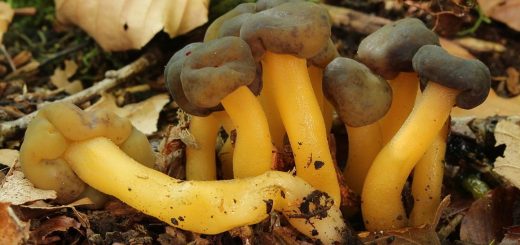#104: Hydnum repandum, the Hedgehog Mushroom
This edible mushroom resembles the chanterelles in looks, flavor, and microscopic characteristics. The one big difference: it has teeth underneath its cap!
Hydnum repandum is a medium-sized to large mushroom that grows 2 to 17cm (about 1 to 7in) in diameter and 3 to 10cm (about 1 to 4in) tall. In good years, however, the mushrooms can get much bigger: up to 30cm (1 foot) in diameter! Its upper surface is convex to flat with a depressed center and has a roundish to lobed and wavy margin, much like the top of a Golden Chanterelle. The Hedgehog Mushroom, however, has colors that are much more muted: its cap is tan to pale tan, usually darkening with age. Underneath, the mushroom features cone-shaped protrusions of its spore surface known as “teeth” or “spines.” These distinctive features resemble very short (2 to 7mm) hedgehog spines, thus earning the mushroom its common name. Each spine is oriented perpendicular to the ground, which allows the discharged spores to drop straight down into air currents. The teeth run down the stem and are whitish in color, sometimes tinted with orange. H. repandum has a whitish to tan stipe that meets the cap roughly at the center. Its flesh is whitish, brittle, and bruises brownish.
You can find the Hedgehog Mushroom on the ground underneath conifers and hardwoods in North America and Europe. H. repandum fruits from summer through fall in most areas, but along the West Coast it usually appears in winter (often after January 1). The mushrooms fruit gregariously, meaning numerous, single fruiting bodies are produced over a wide area.
There are not many look-alikes to H. repandum in North America. The roughly central stipe, toothed pore surface, and growth on the ground separate it from nearly all other mushrooms. It may be confused with a number of species in the Hydnum genus. The easiest of these to separate out is H. umbilicatum, which can be distinguished by its smaller size and bellybutton-like central depression. Other species differ in spore size, distribution, and/or taste. Consult a dichotomous key for identification to species. Before the mushroom hunter examines the underside of the Hedgehog Mushroom, it may appear similar to a number of Cantharellus species (chanterelles). In fact, the genus Hydnum is placed in the order Cantharellales, which also contains many chanterelles, including Golden Chanterelles!
The Hedgehog Mushroom is a good edible when young and firm, and you often find enough to make a meal thanks to its large size and gregarious fruiting habit. Like chanterelles, Hedgehog Mushrooms go well in many different dishes (see the Mycological Society of San Fransico’s page* for recipes)! They may taste bitter if undercooked, so make sure to cook your specimens thoroughly. The mushrooms can be preserved by pickling or freezing, but drying them is inadvisable.
See Further:
http://www.mushroomexpert.com/hydnum_repandum.html
http://www.mykoweb.com/CAF/species/Hydnum_repandum.html
http://botit.botany.wisc.edu/toms_fungi/oct2004.html








![#011: Characteristics of Kingdom Fungi [Archived]](https://www.fungusfactfriday.com/wp-content/themes/hueman/assets/front/img/thumb-small-empty.png)

1 Response
[…] fungi can form a variety of different shapes. One of the most commonly eaten toothed fungi, Hydnum repandum (commonly known as the “Hedgehog Mushroom”), has a pileus and central stipe that is reminiscent […]